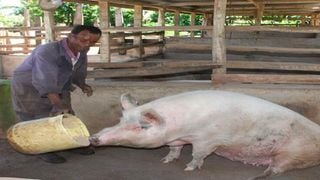
A farmer feeds his pigs at Green Estate in Elburgon, Nakuru County.
| File | Nation Media GroupSeeds of Gold
Premium
Avoid losses, don’t overfeed finisher pigs
What you need to know:
- The pig body requires time to digest feed that is then absorbed and converted to fat, muscle and other tissues hence increasing the weight.
- As pigs grow older, their rate of growth also reduces since they are getting closer to their adult weight and size.
For the past weeks, I have narrated a number of experiences with pigs because many farmers had asked me questions relating to those issues. More questions have continued to pour in. In this article, I will share some responses to two frequently asked questions.
Githaiga from Nairobi was keen to find out the progress scientists have made in developing an African swine fever (ASF) vaccine. He was concerned that the devastating disease has been neglected for the more than 100 years of its existence having been discovered in East Africa.
The farmer was worried that the disease is neglected because it does not affect the developed world.
My opinion is that ASF has not been neglected. The virus is one of the most complicated to deal with that scientists find difficult to develop vaccines.
This was the case with the old vaccine development technologies which mainly relied on either making a virus lose its ability to cause cell damage, known as pathogenicity or inactivating the virus to make it unable to infect.
Newer vaccinology techniques such as gene editing, use of viral units rather than the whole virus, use of harmless carrier viruses and development of continuous cell lines have rekindled the scientific research interest to develop vaccines even from the complex viruses.
Harmless carrier viruses do not cause disease in one species of animal but can be used to carry selected genes of an infective virus into the cells of the host species.
Infective virus proteins
The selected genes command the host cells to produce the infective virus proteins without causing disease to the animal. The animal body then produces protective antibodies that prevent infection. Such vaccines are scientifically called “vectored vaccines”.
A good example of advances in vaccinology is the way many effective types of coronavirus vaccines have been developed in record time to combat Covid-19 in humans.
Githaiga and other pig farmers have a reason to be optimistic that an effective vaccine for the ASF is in the offing. The Pirbright Institute of the United Kingdom published a report to that effect in the journal Vaccines in May 2020. Their scientists had developed an ASF vaccine that, in the laboratory, protected all the pigs in the trial from developing severe disease.
The vaccine is undergoing field trials to prove its efficacy. More research is also being carried out to refine the vaccine in an attempt to make it fully protective against ASF infection. The Pirbright Institute has carried out research on ASF vaccine development since 1963. Veterinary researchers had, therefore, not neglected the disease but they had all along experienced challenges that were difficult to surmount.
Another encouraging report came from the United States Department of Agriculture in May published on their website and the Journal of Virology. The Department’s Agriculture Research Service (ARS) said it had adapted an ASF vaccine candidate to grow in a continuous cell line.
The research achievement is important because it will enable vaccine producers to manufacture ASF vaccine on a large-scale without using live pigs and their fresh cells.
Continuous cell lines grow perpetually as long as they are nourished, according to their specific requirements.
Recommended quantity of feed
Scientists know clearly that the only way of possibly eradicating ASF is large-scale production of an effective vaccine and sustained mass vaccination of domestic pigs globally. Pig farmers and Kenyan animal health scientists must keep following developments of the ASF vaccine research for prompt adaptation once an effective product is available for use.
Francis from Isinya and other farmers wanted to know why feeding finisher pigs with large quantities of feed daily does not result in corresponding weight gains. Well, I put it this way: If you have attained gear 5 in your car and you press the accelerator pedal to the floor, the car will not move faster. It will produce smoke and unburnt fuel.
The pig body requires time to digest feed that is then absorbed and converted to fat, muscle and other tissues hence increasing the weight. As pigs grow older, their rate of growth also reduces since they are getting closer to their adult weight and size.
At the same time, there are growth processes such as bone solidification that you are not able to observe. Bone solidification, for instance, is important to enable the pig to carry the increased body weight.
Therefore, excess feed results in production of more dung and reduction of carcass quality due to build-up of excess fat. Overfeeding finishing pigs, in essence, incurs a loss to the farmer through wasted feed, lower carcass price and increased cost of cleaning the pig pens.
The recommended quantity of the feed for every stage of production of pigs is based on scientific and business calculations to help the farmer maximise on profit. It is anchored on the quality of feed, growth rate of each stage and the desired body condition of the pig at each stage of production.





